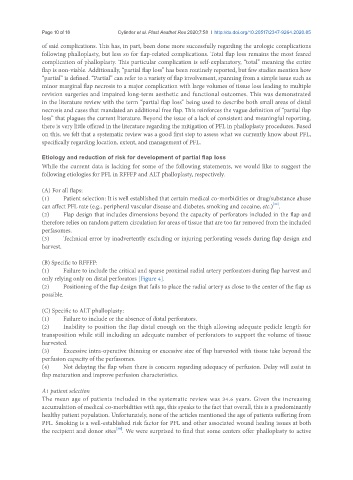Page 676 - Read Online
P. 676
Page 10 of 18 Cylinder et al. Plast Aesthet Res 2020;7:58 I http://dx.doi.org/10.20517/2347-9264.2020.85
of said complications. This has, in part, been done more successfully regarding the urologic complications
following phalloplasty, but less so for flap-related complications. Total flap loss remains the most feared
complication of phalloplasty. This particular complication is self-explanatory, “total” meaning the entire
flap is non-viable. Additionally, “partial flap loss” has been routinely reported, but few studies mention how
“partial” is defined. “Partial” can refer to a variety of flap involvement, spanning from a simple issue such as
minor marginal flap necrosis to a major complication with large volumes of tissue loss leading to multiple
revision surgeries and impaired long-term aesthetic and functional outcomes. This was demonstrated
in the literature review with the term “partial flap loss” being used to describe both small areas of distal
necrosis and cases that mandated an additional free flap. This reinforces the vague definition of “partial flap
loss” that plagues the current literature. Beyond the issue of a lack of consistent and meaningful reporting,
there is very little offered in the literature regarding the mitigation of PFL in phalloplasty procedures. Based
on this, we felt that a systematic review was a good first step to assess what we currently know about PFL,
specifically regarding location, extent, and management of PFL.
Etiology and reduction of risk for development of partial flap loss
While the current data is lacking for some of the following statements, we would like to suggest the
following etiologies for PFL in RFFFP and ALT phalloplasty, respectively.
(A) For all flaps:
(1) Patient selection: It is well established that certain medical co-morbidities or drug/substance abuse
[30]
can affect PFL rate (e.g., peripheral vascular disease and diabetes, smoking and cocaine, etc.) .
(2) Flap design that includes dimensions beyond the capacity of perforators included in the flap and
therefore relies on random pattern circulation for areas of tissue that are too far removed from the included
perfasomes.
(3) Technical error by inadvertently excluding or injuring perforating vessels during flap design and
harvest.
(B) Specific to RFFFP:
(1) Failure to include the critical and sparse proximal radial artery perforators during flap harvest and
only relying only on distal perforators [Figure 4].
(2) Positioning of the flap design that fails to place the radial artery as close to the center of the flap as
possible.
(C) Specific to ALT phalloplasty:
(1) Failure to include or the absence of distal perforators.
(2) Inability to position the flap distal enough on the thigh allowing adequate pedicle length for
transposition while still including an adequate number of perforators to support the volume of tissue
harvested.
(3) Excessive intra-operative thinning or excessive size of flap harvested with tissue take beyond the
perfusion capacity of the perfasomes.
(4) Not delaying the flap when there is concern regarding adequacy of perfusion. Delay will assist in
flap maturation and improve perfusion characteristics.
A1 patient selection
The mean age of patients included in the systematic review was 34.6 years. Given the increasing
accumulation of medical co-morbidities with age, this speaks to the fact that overall, this is a predominantly
healthy patient population. Unfortunately, none of the articles mentioned the age of patients suffering from
PFL. Smoking is a well-established risk factor for PFL and other associated wound healing issues at both
[30]
the recipient and donor sites . We were surprised to find that some centers offer phalloplasty to active

